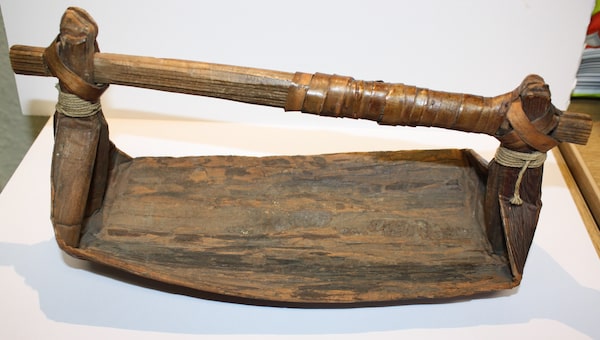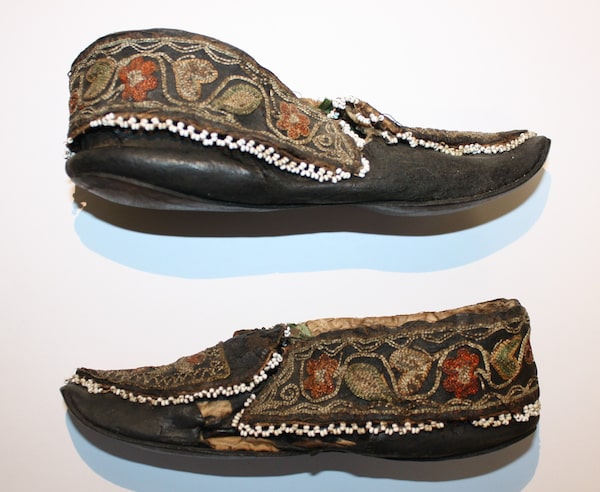
A Kwakwaka’wakw canoe bailer that will be sent to the U’Mista Cultural Centre in Alert Bay, B.C.Supplied
The objects arrived on Haida Gwaii in late August from Britain – among them a heavy, intricate argillite carving of a ceremonial feast platter depicting a rockfish and orcas and inlaid with bone, likely made in the late 19th century.
“That platter was very amazing to hold,” says Aay Aay, repatriation co-ordinator for Saahlinda Naay, the Haida Gwaii Museum in Skidegate, B.C. “The weight of it and then looking at the style of the carvings, the cross-hatching and everything, it was spectacular.”
There was also a painted wooden ladle, probably alder – it’s difficult to tell because of its patina – and, like the platter, certainly used for potlatch ceremonies.
The items are part of an unusual and significant repatriation from a small museum in England’s Peak District. Rather than the community asking for the items back, it was initiated by the British museum – with an unconditional offer of return.
“It’s the right thing to do and it’s the only thing to do,” says Bret Gaunt, with the Buxton Museum and Art Gallery in Derbyshire, who recently returned to Britain from Haida Gwaii. “It was probably a once-in-a lifetime opportunity to do a project like this.”
Opinion: Indigenous communities in B.C. join global movement to repatriate lost artifacts
The Haida Gwaii Museum has received numerous repatriations, including from the Museum of Vancouver and other private collectors. But this offer was a surprise.
“He reached out to me. I was sort of blown away,” says Jisgang/Nika Collison, executive director and curator of the Haida Gwaii Museum. “This has nothing to do with British law. This is humanity.”
The Buxton Museum is run by the Derbyshire County Council. Facing budget cuts, the council was winding down a decades-old program. The Derbyshire School Library Service was set up in the 1930s, thanks to a Carnegie grant, to collect museum-quality objects that would be sent to schools in isolated rural villages of the area. They collected thousands of items, including what they called world cultures objects.
Access to museums has come a long way for these communities since then and, with the county’s financial challenges, a decision was made to end the program.
The Buxton Museum received funding to find ethical solutions regarding what to do with the collection. It decided to hold on to some items and offer some for transfer to other museums. But, with Indigenous communities around the world asking for their objects back, Gaunt recognized the opportunity to do something more.
“I remember looking through the boxes and seeing that there was a group of objects related to Native American and First Nations culture,” says Gaunt, who is assistant collections officer, restitution and repatriation. “And I had a chat with my boss and I said it would be nice if we could repatriate these objects rather than send them to another museum. Because they’re just going to end up sitting in [storage] and not being fully appreciated.”
There can be issues, he notes, with the way these objects are displayed. “The U.K. are full of items. And very often they’re not interpreted correctly.”
The museum put a selection of items on display and asked for public feedback. “It was overwhelmingly positive and in agreement that objects should be repatriated,” Gaunt recalls. “So the tide is certainly turning.”
Indigenous groups in Canada call for return of artifacts, Vatican says they were ‘gifts’
Five objects were returned to Haida Gwaii this summer, although a fish carving they thought was argillite, but is actually slate, is a mystery. The Haida museum is working on determining where it should go. A painted bone totem pole might also turn out not to be Haida. But the platter, the ladle and an argillite boat panel pipe certainly are. The delicate pipe arrived broken, but Aay Aay says it is easily fixable.
The plan is to eventually put these items on display at the museum in Skidegate.
Other objects coming back to First Nations in Canada from the Buxton Museum include a Nuu-chah-nulth canoe paddle, a Kwakwaka’wakw canoe bailer that will be sent to the U’Mista Cultural Centre in Alert Bay, B.C., and several objects going to Ontario, including an Anishinabek tobacco bag. A pair of Huron moccasins will go to the Huron-Wendat Museum in Quebec. Gaunt is still looking for the right home for a fragment of Cree clothing.

A pair of Huron moccasins will go to the Huron-Wendat Museum in Quebec.Supplied
The museum is also repatriating objects to the United States.
The Indigenous items were largely purchased from antique dealers in Britain – mainly in the Midlands and the north of England, but also from some high-end galleries in London. Some had been donated and others purchased in Canada by the founder of the library service, who visited this country in the 1950s.
Tracing how the items got to the antique dealers is challenging. “The records are a bit patchy,” Gaunt says. But he feels certain that at least some would have been acquired under duress during the potlatch ban, which went into effect in 1885 and didn’t end until 1951.
Gaunt says he was nervous about approaching First Nations in North America about the repatriation, but everyone has been receptive. And he has been talking to other British institutions about the success of the project. “It’s encouraging other museums in the U.K. to look at their collections and to think about decolonialization and to return objects unconditionally.”
A fellowship that funded this project allowed Gaunt to travel to B.C. to visit the museum and meet with members of the Haida community this summer. Shortly after he landed on Haida Gwaii, the items he had sent arrived.
“Seeing the objects back on Haida Gwaii was quite emotional,” Gaunt says. “They had come full circle and were back where they belonged.”